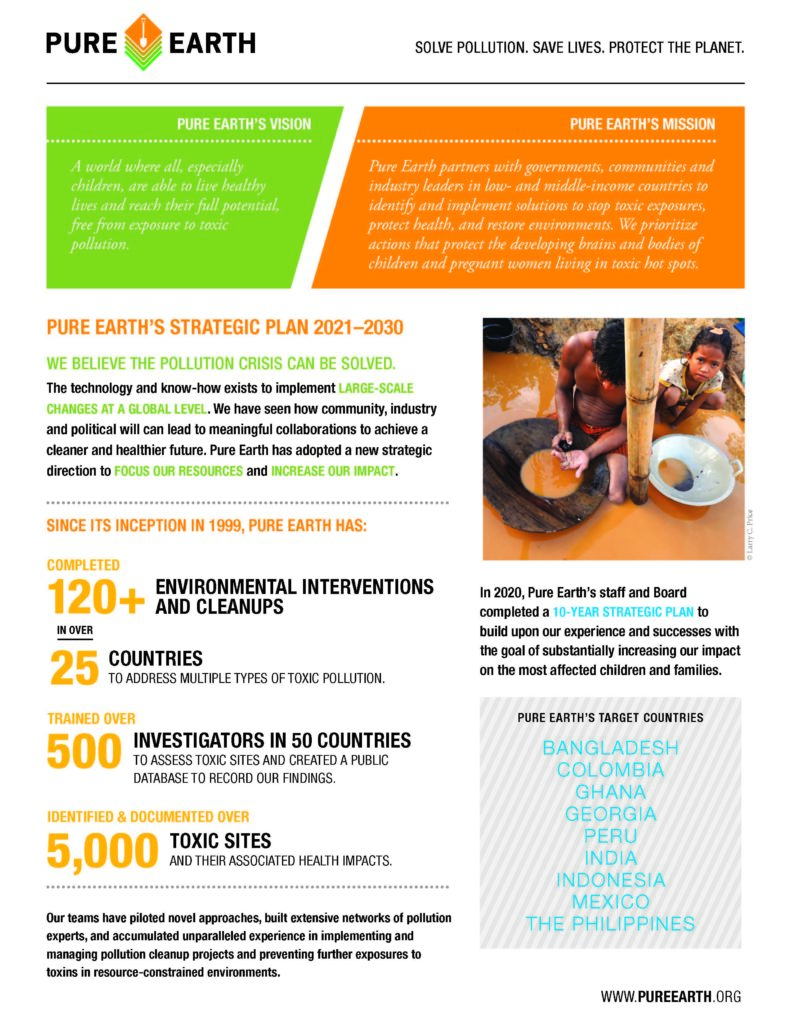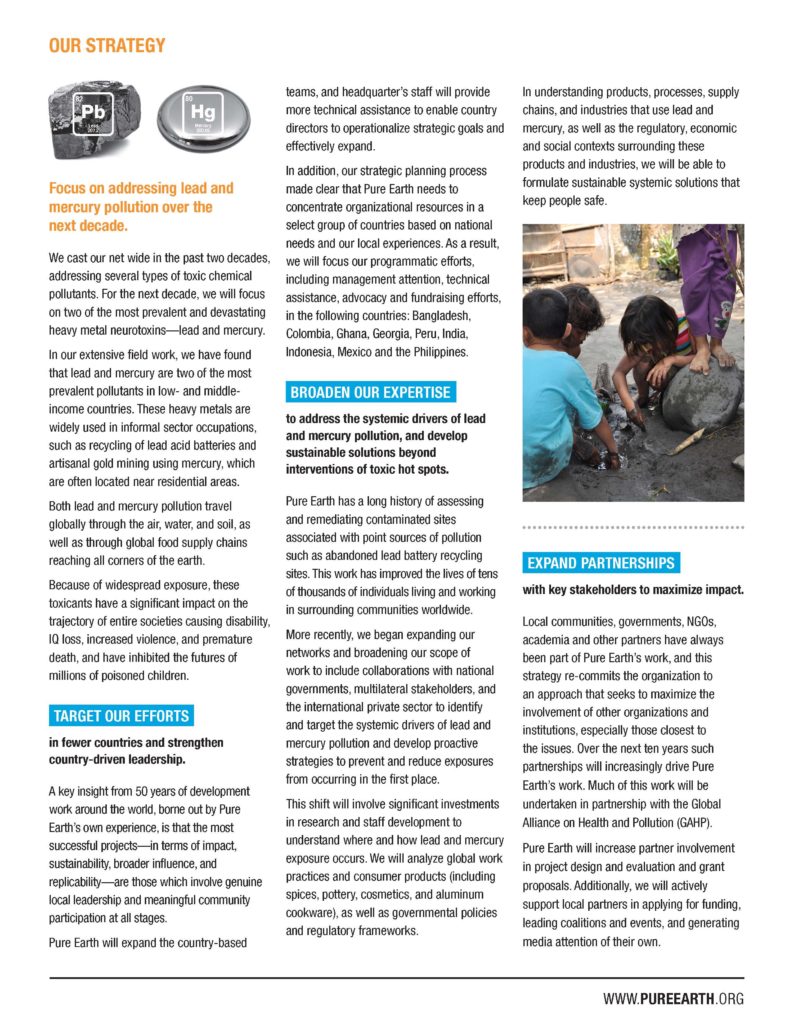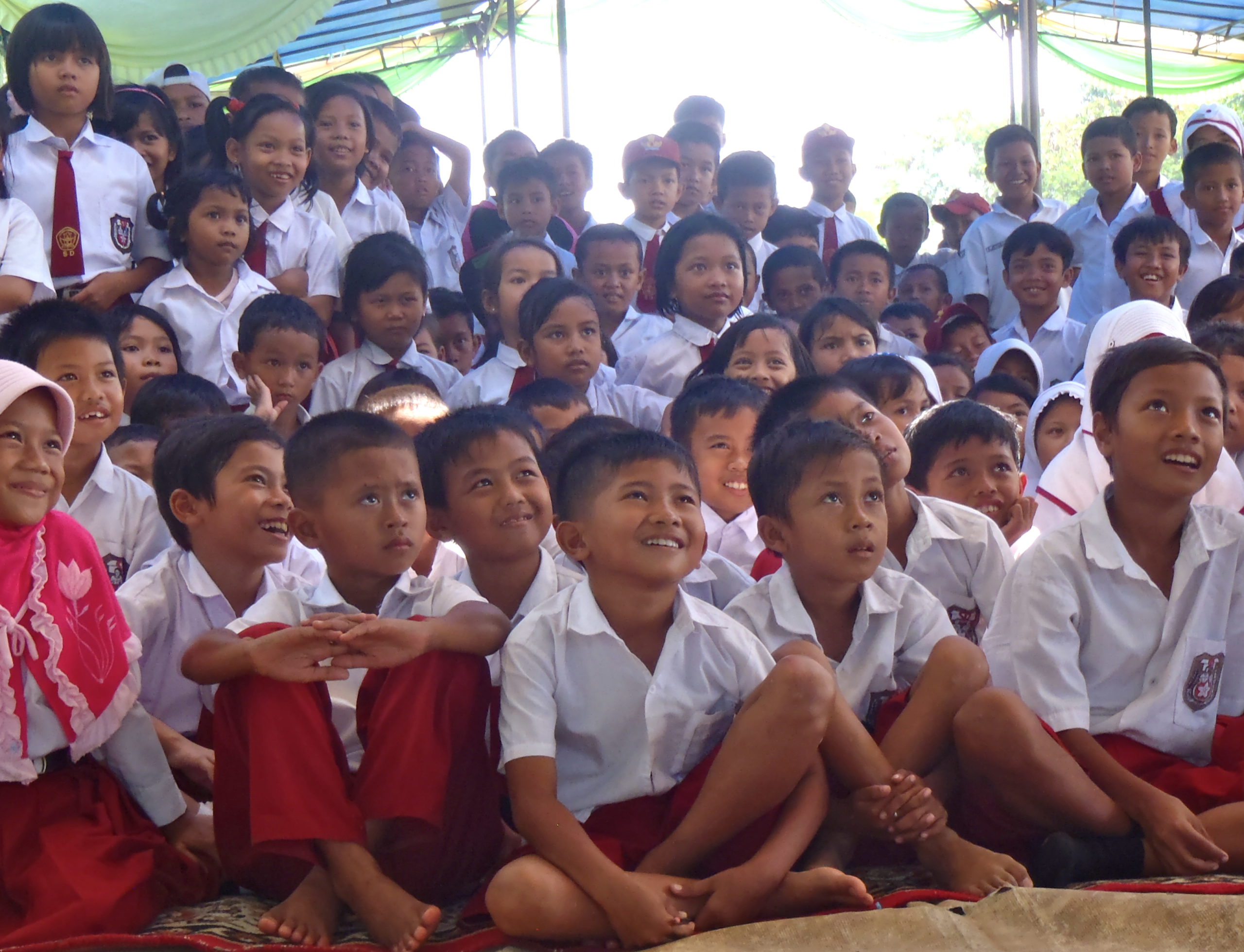Download Spanish Version French Version


Download Spanish Version French Version
Sharpening our focus
As the leading global non-profit addressing toxic pollution, we seek to sharpen our focus in the next decade and increase our impact with a new strategic direction.
Our teams have piloted multiple approaches, built extensive networks and have accumulated much experience in how to cleanup and prevent further exposures to toxins with limited resources/in resource-constrained environments.
In 2020, Pure Earth’s staff and Board completed a 10-year Strategic Plan with the goal of increasing our impact and reducing deaths from pollution in the next decade.
Pure Earth will focus on addressing lead and mercury pollution in the next decade.
We have cast our net wide in the past 2 decades, addressing several types of toxic chemical pollutants. For the next decade we will focus on two of the most prevalent and devastating heavy metal neurotoxins – lead and mercury.
In our extensive field work we have found that lead and mercury are two of the most prevalent pollutants in low and middle-income countries. There is widespread use of, and exposure to dangerous forms of lead and mercury through processing in informal occupational settings, often close to, or in residential areas.
Of WHO’s top ten chemicals of major public health concern, we believe that lead and mercury are the two most dangerous neurotoxins, with exposures resulting in birth defects, brain damage, cardiovascular, kidney disease, and much more.
Lead does not break down and stays where it is for hundreds of years and continues to poison communities until it is cleaned up/removed/remediated. Lead pollution and exposure results in multigenerational poisoning; when girls are exposed to lead, it gets stored in their bones. When they become pregnant, the lead in their bones gets released and crosses the placenta into the fetus because the body interprets lead as calcium. Lead also flows from the mother’s bones into breast milk.
Mercury wreaks similar damage on mothers and infants. It crosses the placenta, poisoning the fetus. Mercury is highly mobile in the environment; it bioaccumulates and transforms in aquatic environments into highly toxic methyl-mercury. This is why pregnant women are advised to limit intake of certain types of fish.
Both heavy metal toxins are widely used in informal sector occupations of recycling lead acid car batteries and small scale gold mining using mercury. Both require no training or capital investment to get started; both pay better than farming and other traditional occupations.
Both lead and mercury pollution travel through the global environment in air, water, soil, and through global food supply chains to reach all corners of the earth.
Because of widespread exposure, both toxicants have a significant impact on the trajectory of societies causing disability, IQ loss, increased violence and restricted futures for poisoned children.
More than 800 million children globally have a concentration of lead in their blood above 5 micrograms per deciliter – resulting in permanent brain damage and the loss of 3 to 5 IQ points. Childhood lead exposure is estimated to cost lower- and middle-income countries almost USD $1 trillion due to the lost economic potential of these children over their lifetime.
Pure Earth will target our efforts in fewer countries and shift to a country-driven leadership strategy.
A key insight from fifty years of development work around the world, borne out by Pure Earth’s own experience, is that the most successful projects – in terms of impact, sustainability, and broader influence and replicability – are those which involve genuine local leadership and meaningful community participation at all stages.
Pure Earth will shift the way we work, moving away from New York headquarters staff defining and directing projects remotely, to a country-driven strategy where our country directors have greater authority to operationalize strategic goals and execute projects with HQ staff providing more of a support role.
In addition to focusing our efforts primarily on lead and mercury, and shifting to a country-driven approach, it became clear in the strategic planning process that Pure Earth needed to
concentrate organizational resources in fewer countries. Country selection criteria were developed and applied, leading with national need and resulted in the selection of the following countries for Pure Earth’s core programmatic work: Bangladesh, Colombia (with outreach to Peru), India, Indonesia, Mexico and Philippines.
These are the countries where Pure Earth will focus its organizational resources, including management attention, technical assistance, advocacy and fundraising efforts. These country program offices will be built up, for the purpose of creating conditions and capacities for well-managed country-driven programming.
Pure Earth will broaden our expertise to address the systemic drivers of lead and mercury pollution, and develop sustainable solutions beyond interventions of toxic hot spots.
Pure Earth has developed significant expertise in contaminated site assessment and remediation associated with “point sources” such as abandoned lead battery smelting sites. In order to broaden our impact, we will shift significant resources to developing a more proactive strategy to prevent and reduce lead and mercury pollution from occurring in the first place.
Pure Earth will develop and expand its capacity, and that of partner organizations and government stakeholders, to understand lead exposure from a broader set of sources, including consumer products such as spices, pottery, cosmetics, and aluminum pots and pans.
Overall, Pure Earth will invest in its capacity to understand products, processes and industries that use lead and mercury that contribute to exposures, as well as the regulatory, economic and social contexts surrounding these products and industries with the goal of formulating broader systemic solutions.
Partnerships are critical to solving pollution and Pure Earth will expand partnership efforts to maximize impact from all involved.
Community, government, NGO, academic and other partners have always been part of Pure Earth’s work, and this strategy recommits the organization to an approach that seeks to maximize the involvement of other organizations and institutions, especially local ones. Over the next ten years such partnerships will increasingly drive Pure Earth’s work. Much of this work will be undertaken in partnership with GAHP.
Pure Earth will retool its partnership approach and practices to engage local organizations as part of proposals to funders, design of projects, providing technical and financial inputs to projects, determining behavior change methodologies that are most effective in their communities, and undertaking project monitoring, evaluation and learning activities. Additionally, Pure Earth will actively support local partners in applying for funding, leading coalitions and events, and generating media attention of their own, not only as vehicles for Pure Earth’s success and recognition.
Pure Earth will continue to prioritize and expand research efforts.
Pure Earth’s strategic research approach is based on three components, designed to ensure that our work is informed by the best possible information, that such information is shared broadly, and that activities to reduce exposure are replicable, sustainable, and result in measurable improvements in blood lead levels.
● Data Collection:
Collect information on the scope, severity, demographics, impacts and sources of lead exposure in selected geographies to increase the efficacy and efficiency of subsequent intervention design and implementation. This component includes conducting baseline and end-line blood lead level (BLL) assessments; conducting rapid baseline and end-line marketplace surveys or home-based source analyses to identify main sources of lead; conducting value or supply chain tracking of lead containing products; reviewing current regulatory frameworks and gaps; creating a case studies; and other activities to monitor progress and outcomes.
● Influence:
Share data and case studies with local, national, and international stakeholders to: develop educational materials for consumers; develop education and/or training materials for producers; sensitize governments to potential intervention strategies and develop joint action plans; and increase the effectiveness of lead exposure reduction programs.
● Intervention/Impact:
Implement lead exposure prevention and source control measures for priority sources with local partners to reduce lead exposures from identified sources and decrease baseline blood lead levels: provide technical assistance to governments to enforce regulations; roll out public/consumer education and producer training programs.
Learn more about the Strategic Plan

